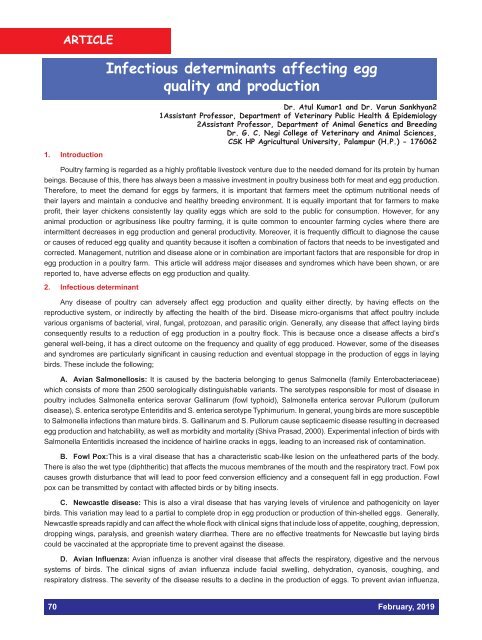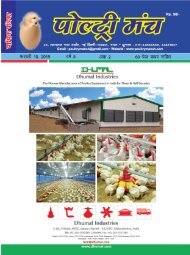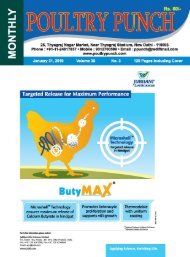POULTRY PUNCH - FEBRUARY 2019
POULTRY PUNCH - FEBRUARY 2019
POULTRY PUNCH - FEBRUARY 2019
- No tags were found...
Create successful ePaper yourself
Turn your PDF publications into a flip-book with our unique Google optimized e-Paper software.
ARTICLE NEWS<br />
Infectious determinants affecting egg<br />
quality and production<br />
1. Introduction<br />
Dr. Atul Kumar1 and Dr. Varun Sankhyan2<br />
1Assistant Professor, Department of Veterinary Public Health & Epidemiology<br />
2Assistant Professor, Department of Animal Genetics and Breeding<br />
Dr. G. C. Negi College of Veterinary and Animal Sciences,<br />
CSK HP Agricultural University, Palampur (H.P.) - 176062<br />
Poultry farming is regarded as a highly profitable livestock venture due to the needed demand for its protein by human<br />
beings. Because of this, there has always been a massive investment in poultry business both for meat and egg production.<br />
Therefore, to meet the demand for eggs by farmers, it is important that farmers meet the optimum nutritional needs of<br />
their layers and maintain a conducive and healthy breeding environment. It is equally important that for farmers to make<br />
profit, their layer chickens consistently lay quality eggs which are sold to the public for consumption. However, for any<br />
animal production or agribusiness like poultry farming, it is quite common to encounter farming cycles where there are<br />
intermittent decreases in egg production and general productivity. Moreover, it is frequently difficult to diagnose the cause<br />
or causes of reduced egg quality and quantity because it isoften a combination of factors that needs to be investigated and<br />
corrected. Management, nutrition and disease alone or in combination are important factors that are responsible for drop in<br />
egg production in a poultry farm. This article will address major diseases and syndromes which have been shown, or are<br />
reported to, have adverse effects on egg production and quality.<br />
2. Infectious determinant<br />
Any disease of poultry can adversely affect egg production and quality either directly, by having effects on the<br />
reproductive system, or indirectly by affecting the health of the bird. Disease micro-organisms that affect poultry include<br />
various organisms of bacterial, viral, fungal, protozoan, and parasitic origin. Generally, any disease that affect laying birds<br />
consequently results to a reduction of egg production in a poultry flock. This is because once a disease affects a bird’s<br />
general well-being, it has a direct outcome on the frequency and quality of egg produced. However, some of the diseases<br />
and syndromes are particularly significant in causing reduction and eventual stoppage in the production of eggs in laying<br />
birds. These include the following;<br />
A. Avian Salmonellosis: It is caused by the bacteria belonging to genus Salmonella (family Enterobacteriaceae)<br />
which consists of more than 2500 serologically distinguishable variants. The serotypes responsible for most of disease in<br />
poultry includes Salmonella enterica serovar Gallinarum (fowl typhoid), Salmonella enterica serovar Pullorum (pullorum<br />
disease), S. enterica serotype Enteriditis and S. enterica serotype Typhimurium. In general, young birds are more susceptible<br />
to Salmonella infections than mature birds. S. Gallinarum and S. Pullorum cause septicaemic disease resulting in decreased<br />
egg production and hatchability, as well as morbidity and mortality (Shiva Prasad, 2000). Experimental infection of birds with<br />
Salmonella Enteritidis increased the incidence of hairline cracks in eggs, leading to an increased risk of contamination.<br />
B. Fowl Pox:This is a viral disease that has a characteristic scab-like lesion on the unfeathered parts of the body.<br />
There is also the wet type (diphtheritic) that affects the mucous membranes of the mouth and the respiratory tract. Fowl pox<br />
causes growth disturbance that will lead to poor feed conversion efficiency and a consequent fall in egg production. Fowl<br />
pox can be transmitted by contact with affected birds or by biting insects.<br />
C. Newcastle disease: This is also a viral disease that has varying levels of virulence and pathogenicity on layer<br />
birds. This variation may lead to a partial to complete drop in egg production or production of thin-shelled eggs. Generally,<br />
Newcastle spreads rapidly and can affect the whole flock with clinical signs that include loss of appetite, coughing, depression,<br />
dropping wings, paralysis, and greenish watery diarrhea. There are no effective treatments for Newcastle but laying birds<br />
could be vaccinated at the appropriate time to prevent against the disease.<br />
D. Avian Influenza: Avian influenza is another viral disease that affects the respiratory, digestive and the nervous<br />
systems of birds. The clinical signs of avian influenza include facial swelling, dehydration, cyanosis, coughing, and<br />
respiratory distress. The severity of the disease results to a decline in the production of eggs. To prevent avian influenza,<br />
70 February, <strong>2019</strong>






